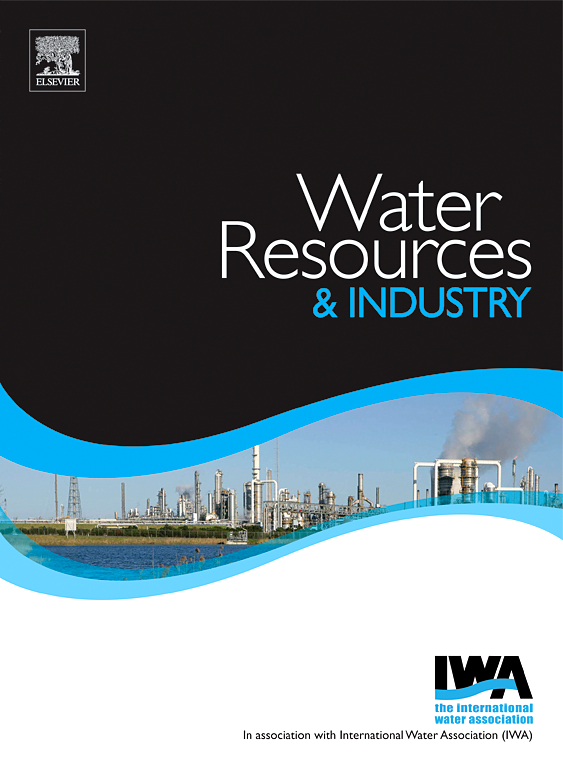胺类有机化合物沉淀制碱废水中离子的效果分析
IF 7.5
3区 工程技术
Q1 WATER RESOURCES
引用次数: 0
摘要
处理苏打工业的废水是一个复杂而漫长的过程,需要大量的人力和财力。目前还没有一种方法可以完全消除苏打工业对环境造成的破坏。高度污染的苏打生产废水渗漏到土壤、地下水和地表水中,会腐蚀水利基础设施,导致饮用水和农业用水的水质恶化。生产后废水造成的土壤污染会导致水土流失,并对植被产生不利影响。这项工作的重点是使用异丙胺(IPA)、二异丙胺(DIPA)、丙胺(PA)和乙胺(EA)等不同比例的有机溶剂,通过沉淀去除制碱废水中的氯化物、硫酸盐、钙和钠。通过贝叶斯贝塔回归法建立统计模型,以选择能最有效地去除沉淀形式的受测离子的胺。此外,还研究了沉淀剂用量对溶液 pH 值和电导率的影响。苏打工业废水样本的特点是 pH 值高(高达 11.9),比电解电导率高(高达 128 mS cm-1),钠离子(高达 13 g L-1)、氯离子(高达 60 g L-1)和钙离子(高达 24 g L-1)浓度高。溶剂沉淀法表明,有机溶剂能有效沉淀制碱工业废水中的盐分。硫酸盐和氯化物的去除率分别为 85.1% 和 34%。统计分析显示,异丙胺是去除离子最有效的胺。本文章由计算机程序翻译,如有差异,请以英文原文为准。
Analysis of the effectiveness of organic compounds from the amine group in precipitating ions from soda production wastewater
Treating wastewater from the soda industry is a complicated and lengthy process, requiring a great deal of labor and financial resources. No method has yet been developed to eliminate the environmental damage caused by the soda industry entirely. The leakage of highly contaminated soda production wastewater into soils, groundwater, and surface water can cause corrosion of water infrastructure and deterioration of water quality for both drinking and agricultural use. Soil contamination from post-production wastewater leads to erosion and adversely affects vegetation. The work focused on the removal of chloride, sulfate, calcium, and sodium from soda production wastewater by precipitation using organic solvents such as isopropylamine (IPA), diisopropylamine (DIPA), propylamine (PA) and ethylamine (EA) in various proportions. Statistical modelling through Bayesian beta regression was used to select the amine most effectively removing the tested ions in precipitate form. The effect of precipitating agent dosage on the pH and conductivity of the solution was also investigated. Samples of wastewater obtained from the soda industry were characterized by high values of pH (up to 11.9), specific electrolytic conductivity (up to 128 mS cm−1), and high concentrations of sodium (up to 13 g L−1), chloride (up to 60 g L−1) and calcium (up to 24 g L−1) ions. Solvent-based precipitation showed that organic solvents are effective in precipitating salts from wastewater from the soda industry. Sulfate and chloride removal efficiencies of 85.1 and 34 %, respectively, were observed. Statistical analysis showed that isopropylamine was the most effective amine for ion removal.
求助全文
通过发布文献求助,成功后即可免费获取论文全文。
去求助
来源期刊

Water Resources and Industry
Social Sciences-Geography, Planning and Development
CiteScore
8.10
自引率
5.90%
发文量
23
审稿时长
75 days
期刊介绍:
Water Resources and Industry moves research to innovation by focusing on the role industry plays in the exploitation, management and treatment of water resources. Different industries use radically different water resources in their production processes, while they produce, treat and dispose a wide variety of wastewater qualities. Depending on the geographical location of the facilities, the impact on the local resources will vary, pre-empting the applicability of one single approach. The aims and scope of the journal include: -Industrial water footprint assessment - an evaluation of tools and methodologies -What constitutes good corporate governance and policy and how to evaluate water-related risk -What constitutes good stakeholder collaboration and engagement -New technologies enabling companies to better manage water resources -Integration of water and energy and of water treatment and production processes in industry
 求助内容:
求助内容: 应助结果提醒方式:
应助结果提醒方式:


